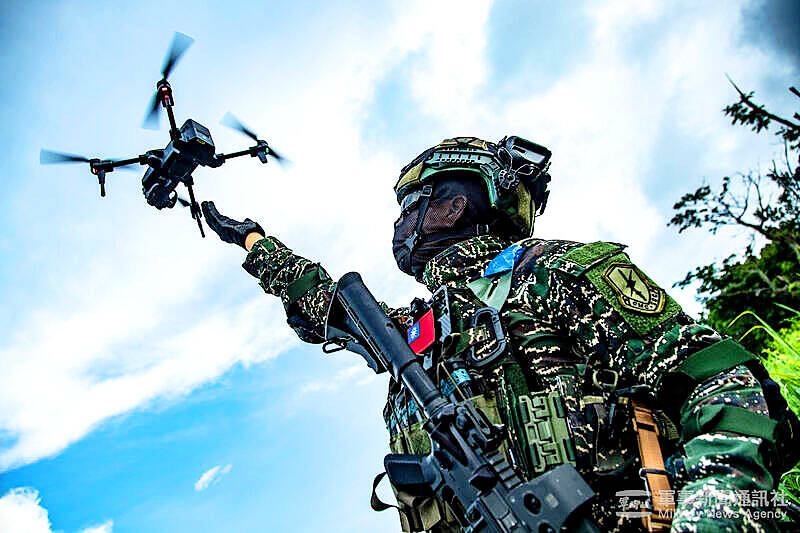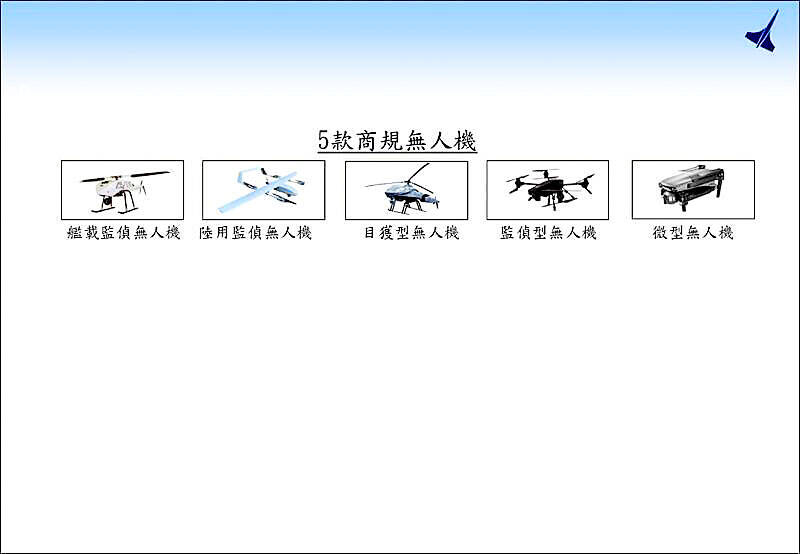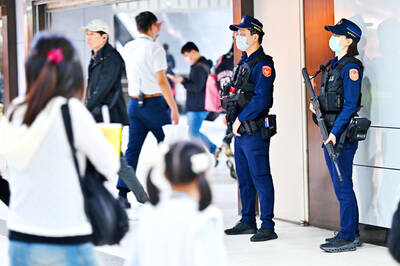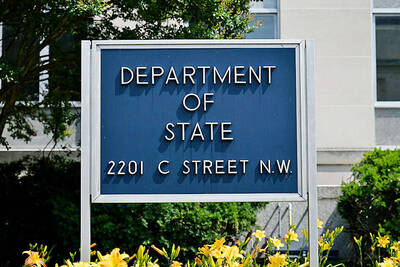The Ministry of National Defense is to acquire an additional 48,750 military-grade commercial uncrewed aerial vehicles (UAVs) over the next two years, an Armaments Bureau notice released on Tuesday on the government’s e-Procurement System showed.
The previous procurement plan is expected to be completed by the end of this year, while the new, independent plan would run through 2027.
The UAV categories in the latest notice are largely in line with those in the previous notice: short and long-range fixed-wing UAVs, rotorcraft UAVs, and vertical takeoff and landing (VTOL) fixed-wing UAVs.

Photo courtesy of the Military News Agency
The bureau’s Material Production and Manufacturing Center has opened solicitations for the five UAV categories, inviting domestic manufacturers to submit models for evaluation.
The five models have been temporarily labeled types A through E, with each given strict technical requirements.
Types A and B are multi-rotor UAVs with 6km and 25km minimum control ranges respectively, the notice said.

Photo courtesy of the Ministry of National Defense
The procurement quantity for type A was 7,500 units next year and 26,500 in 2027, while for Type B it was 1,100 units next year and 3,200 in 2027, it said.
Types C and D are both fixed-wing UAVs, it said.
Type C should have a control range of more than 90km and a minimum flight time of two hours, while Type D should have a control range of at least 30km and at least 30 minutes flight time, the notice said.
The bureau is looking to procure 970 Type C units and 1,350 Type D units next year, and 2,980 Type C units and 4,450 Type D units the following year, it said.
Type E is a VTOL fixed-wing UAV with a control range of more than 100km, a minimum flight time of 2.5 hours, an average cruising speed of more than 80kph and the ability to withstand winds stronger than 5 on the Beaufort scale during takeoff and landing, it said.
Procurement quantities were 350 units per year for next year and 2027.
This latest UAV procurement notice is a significant increase from the ongoing one, which was for just over 3,000 units.
In other news, next year is expected to be the first time the national defense budget would cover four concurrent active special military projects, highlighting the emphasis President William Lai’s (賴清德) administration has put on defense spending.
In addition, the ministry would seek an unspecified special procurement budget for next year, a source said, speaking on condition of anonymity.
The government expects to need hundreds of billions of New Taiwan dollars for arms procurement, as weapons and energy might be bargaining chips in tariff discussions with the US, the source said.
The arms procurement would also go toward Lai’s pledge to push national defense spending to more than 3 percent of GDP, they said.
The ministry has two active special budget programs, the NT$237 billion (US$8.07 billion) Naval-Air Capability Improvements Procurement Project, which began in 2022 and ends next year, and the NT$247 billion Procurement of Updated Fighter Jets Project from 2020 to next year.
Meanwhile, the legislature on July 12 advanced the third reading of the Special Act for Strengthening Economic, Social and National Security Resilience in Response to International Circumstances (因應國際情勢強化經濟社會及國土安全韌性特別條例), which has a budget of NT$115 billion, while the national security resilience budget began this year and runs through 2027.
However, the Executive Yuan and ministries are yet to provide a detailed breakdown of how the national security resilience funding would be distributed each year.
In addition, a second batch of 42 M1A2T Abrams main battle tanks purchased from the US is to arrive at the Port of Taipei late on Saturday, a second source said.
Taiwan has allocated about NT$40.52 billion from 2019 to 2027 to purchase 108 M1A2T tanks from the US with the aim of assigning them to the Sixth Army Corps to defend northern Taiwan.
Additional reporting by CNA

A car bomb killed a senior Russian general in southern Moscow yesterday morning, the latest high-profile army figure to be blown up in a blast that came just hours after Russian and Ukrainian delegates held separate talks in Miami on a plan to end the war. Kyiv has not commented on the incident, but Russian investigators said they were probing whether the blast was “linked” to “Ukrainian special forces.” The attack was similar to other assassinations of generals and pro-war figures that have either been claimed, or are widely believed to have been orchestrated, by Ukraine. Russian Lieutenant General Fanil Sarvarov, 56, head

SAFETY FIRST: Double the number of police were deployed at the Taipei Marathon, while other cities released plans to bolster public event safety Authorities across Taiwan have stepped up security measures ahead of Christmas and New Year events, following a knife and smoke bomb attack in Taipei on Friday that left four people dead and 11 injured. In a bid to prevent potential copycat incidents, police deployments have been expanded for large gatherings, transport hubs, and other crowded public spaces, according to official statements from police and city authorities. Taipei Mayor Chiang Wan-an (蔣萬安) said the city has “comprehensively raised security readiness” in crowded areas, increased police deployments with armed officers, and intensified patrols during weekends and nighttime hours. For large-scale events, security checkpoints and explosives

PUBLIC SAFETY: The premier said that security would be tightened in transport hubs, while President Lai commended the public for their bravery The government is to deploy more police, including rapid response units, in crowded public areas to ensure a swift response to any threats, President William Lai (賴清德) said yesterday after a knife attack killed three people and injured 11 in Taipei the previous day. Lai made the remarks following a briefing by the National Police Agency on the progress of the investigation, saying that the attack underscored the importance of cooperation in public security between the central and local governments. The attack unfolded in the early evening on Friday around Taipei Main Station’s M7 exit and later near the Taipei MRT’s Zhongshan

REBUFFED: In response to Chinese criticism over recent arms sales, Washington urged Beijing to engage in meaningful dialogue instead of threats and intimidation Washington’s long-term commitment to Taiwan would not change, the US Department of State said yesterday, urging Beijing to stop pressuring Taiwan and engage in meaningful bilateral dialogues. The remarks came in response to a backlash from Beijing about Washington’s latest approval of arms sales to Taiwan. The US Defense Security Cooperation Agency said in a statement on Wednesday that the Taipei Economic and Cultural Representative Office in the US has asked to purchase an arms package, including Tactical Mission Network Software; AH-1W helicopter spare and repair parts; M109A7 self-propelled howitzers; HIMARS long range precision strike systems; tube-launched, optically tracked, wire-guided missiles; Javelin